History:
In 1640, a Jesuit priest named Chisel invented a slide projector called the Magic lamp, which was the first projector in the world. Projector, also known as a projector, its development history:
In 1991, developed the world's first data projector (LitePro series).
In 1992, the world's first high-resolution LCD projection board (7600XGA) was developed successfully.
In 1993, the world's first multimedia LCD projector was developed successfully—the first laptop LCD projector.
In 1994, the world's first effective matrix film tube night crystal projection board with high resolution was successfully developed.
In 1995, it successfully developed the world's first polysilicon multimedia projector. The first portable high-resolution (1280*1024) projector.
In 1996, the world's first DMD digital multimedia projector was developed successfully.
In 1998, the world's smallest DLP digital multimedia projector LP425 launched.
In 1999, the world's first generation of network multimedia projector LP755.
In 2000, the world's first DVI notebook projector LP335 launched.
In 2001, the BumbleBee LP130(BumbleBee) is the world's smallest digital projector, weighing only 1.3kg.
In 2002, the world's brightest network digital projector LP650 launched.
In 2003, the handheld digital projector LP70 was launched.
In 2004, the first micro digital projector with LCD screen LP120.
In 2005, it launched the super luxury three-light DLP digital projector SP777.
In 2006, it launched the economic home projection King Play Big IN72.
In 2007, the new business projector IN32 was launched.
In 2008, the ultra-thin pocket projector IN12 was launched.
Supplement:
The Future - Prospects for the Development of Micro Projectors
Today, on the one hand, the brightness of LED light sources has increased, and on the other hand, the mass production of micro-projection chips has also reduced the cost of micro-projectors. With the combination of projection and consumer electronic products such as mobile phones, notebook computers, and portable playback devices, the projection function has also attracted the attention of the public.
Portable projector development trend forecast
According to the analysis report of Pacific Media Association in Q2 2008, portable projectors will grow at an average annual rate of 200%, and at the same time, various products with embedded projection functions will grow at an average annual rate of nearly 300%. speed growth. Combined with the appearance of various micro-projector products at the CES2009 Consumer Electronics Show, it is not difficult for us to imagine how fast the future micro-projectors will develop.
Summary:
Although the miniature projector has only been developed for more than 3 years since it was launched, it is far beyond imagination in terms of its attention and popularity. If the previous projector was doomed to become an office product in a single field for a long time due to its size limitation, then the miniature projection technology combined with various consumer electronics products will expand the application field of projection. become infinite possibilities. Due to the reduction in volume, the shape of the projector can no longer be a boxy instrument. Whether it is the size of a mobile phone or foldable, there are many possibilities for the shape of the projector. The projector is expected to become a new type of equipment after notebooks and mobile phones. fashion consumer electronics. After all, no matter how exquisite a mobile phone, notebook, or portable player is, its display screen size is still limited. With the addition of projection functions, these products can enlarge the small screen and share it everywhere. We are also looking forward to the emergence of more and more perfect micro-projectors.
The advantage of the projector:
- Integrate equipment, from the avenue to the simplicity
In the past, when the projection was installed and used, it was necessary to lay out audio cables, video cables, etc. in advance, and finally connect the content source and speakers before it could be used. The beauty of the interior. Taking XGIMI as an example, it not only comes with rich content sources, but also has built-in internationally renowned Harman Kardon speakers, allowing users to buy and use it without having to consider other factors. Simple operation + excellent experience will naturally attract more users to buy.
- Optimize the video playback experience
The usage scenarios of traditional projection are mainly in the office field or classroom, so the dynamic display of projection is often not paid much attention to, which also leads to the phenomenon of frame drop and freeze due to various reasons when traditional projection plays dynamic video. Seriously affect the viewing experience of users. But when the user group becomes ordinary people and the usage scenario becomes home, the needs are quite different. At this time, the main purpose of projection is to enjoy TV dramas or movies at home, so the requirements for the dynamic performance of projection are very high.
Both XGIMI and Sony have seen such user pain points, so they introduced MEMC motion compensation technology that is only available in high-end TVs, such as XGIMI H2, XGIMI Z6, and Sony’s VPL-VW870ES, etc., so that the projection will automatically calculate and Supplement the missing images between moving objects, so that users can watch smoothly and freely. The football mode unique to the XGIMI Smart Projector optimizes the trajectory of the football and the trajectory of the players with different algorithms, which improves the accuracy of motion estimation and frame insertion. It makes everyone feel more comfortable when watching football games. In the author's opinion, the projection without motion compensation is far inferior to the projection with motion compensation in terms of the viewing experience. Therefore, it is recommended that you must buy a model with motion compensation when purchasing a home projector.
- Ease of use experience
In addition to motion compensation technology, keystone correction technology is also a major pain point for users. It is cumbersome for traditional projectors to realize the regularity of the projection screen, and some even need to manually adjust the feet of the fuselage. At the same time, they are also very particular about the placement of the fuselage. And some relatively "humanized" projectors have a vertical keystone correction function in the system, which makes it easier for users to adjust the picture. XGIMI projectors are more advanced and user-friendly. They have trapezoidal correction functions in four directions, up, down, left, and right, allowing users to place projections arbitrarily. The latest models, such as XGIMI H2 and XGIMI Z6X, have added intelligent auxiliary trapezoid Correction, automatic up, down, left, and right trapezoidal correction is realized. It is worth mentioning that some XGIMI laser projectors even support the automatic alignment of the screen in one shot, so even the laser TV does not need to be manually adjusted. On the whole, the entry of smart projectors such as XGIMI is very friendly to users who want to add projectors after decoration. I believe this is also a major reason for the rapid development of the domestic projection market.




Leave a comment
All comments are moderated before being published.
This site is protected by hCaptcha and the hCaptcha Privacy Policy and Terms of Service apply.